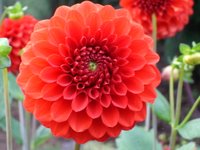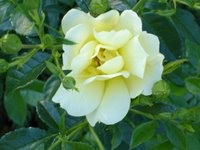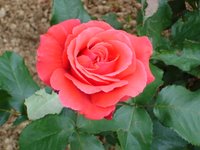 I've always loved this shoot. It's very interesting to me with the static lines crisscrossing the field of the picture and framing the subject. Its a picture of Geum chiloense 'Mrs. Bradshaw' encased with the seed heads of Nassella tenuissima ( Mexican Feather Grass).
I've always loved this shoot. It's very interesting to me with the static lines crisscrossing the field of the picture and framing the subject. Its a picture of Geum chiloense 'Mrs. Bradshaw' encased with the seed heads of Nassella tenuissima ( Mexican Feather Grass).
Tuesday, September 26, 2006
STATIC
 I've always loved this shoot. It's very interesting to me with the static lines crisscrossing the field of the picture and framing the subject. Its a picture of Geum chiloense 'Mrs. Bradshaw' encased with the seed heads of Nassella tenuissima ( Mexican Feather Grass).
I've always loved this shoot. It's very interesting to me with the static lines crisscrossing the field of the picture and framing the subject. Its a picture of Geum chiloense 'Mrs. Bradshaw' encased with the seed heads of Nassella tenuissima ( Mexican Feather Grass).
Monday, September 25, 2006
LAMIUM
 There are several types of Lamium (Dead Nettle). Some have trailing growth and are often used in hanging baskets and other have clump growth and stay fairly compact. The only lamium that I have in the garden is Lamium galeobdolon 'Hermman's Pride' (Yellow Archangel). It's a great plant with beautifully marked foliage and small yellow flowers. Mine is 5 years old and from a 4" pot its only grown to about 18" across. It stands only 10 inches tall and although it can be grown in shade or filtered light I've had mine located in full sun and its never burned. This year I plan to divide it and see how it well liven up some of the shadier areas of my garden, maybe next to some Hostas, Heucheras, and Ferns.
There are several types of Lamium (Dead Nettle). Some have trailing growth and are often used in hanging baskets and other have clump growth and stay fairly compact. The only lamium that I have in the garden is Lamium galeobdolon 'Hermman's Pride' (Yellow Archangel). It's a great plant with beautifully marked foliage and small yellow flowers. Mine is 5 years old and from a 4" pot its only grown to about 18" across. It stands only 10 inches tall and although it can be grown in shade or filtered light I've had mine located in full sun and its never burned. This year I plan to divide it and see how it well liven up some of the shadier areas of my garden, maybe next to some Hostas, Heucheras, and Ferns.
Sunday, September 24, 2006
Saturday, September 23, 2006
CALLUNA
 Calluna vulgaris 'Robert Chapman' is the only Culluna I have in the garden. I choose it not only for it low maintenance-ease of care but for its beautiful fall and winter colour. In spring and summer the foliage is chartreuse then when the weather cools the foliage turns orange and continues to change to a rusty red. Cullana vulgaris is the only true Heather. Erica's are actually Heathes. I've located my Cullana's next to Nepeta (shown in the back ground of photo) and Lamb's Ear (STACHYS Byzantina). All take full sun and infrequent summer watering ounce established. Some other trivial information---Calluna comes from the Greek word meaning broom which years back they used Cullunas for sweeping and vugaris means common.
Calluna vulgaris 'Robert Chapman' is the only Culluna I have in the garden. I choose it not only for it low maintenance-ease of care but for its beautiful fall and winter colour. In spring and summer the foliage is chartreuse then when the weather cools the foliage turns orange and continues to change to a rusty red. Cullana vulgaris is the only true Heather. Erica's are actually Heathes. I've located my Cullana's next to Nepeta (shown in the back ground of photo) and Lamb's Ear (STACHYS Byzantina). All take full sun and infrequent summer watering ounce established. Some other trivial information---Calluna comes from the Greek word meaning broom which years back they used Cullunas for sweeping and vugaris means common.
Friday, September 22, 2006
CANNA TROPICANA


 As mentioned in a previous post I have an affinity for bright coloured flowers. So naturally I'd have to fine a place for at least one Canna Tropicana. The foliage is striking with strips of oranges and reds, and the flowers are the borne on red stems and buds opening up to the most intense orange. This tropical native is not hardy in my area so I keep them potted in frost-free ceramic containers and place them in a protected area for the winter. When growing, I locate them in one of the hottest areas of the garden and give them plenty of water. Some of my contemporaries plant there Cannas in the ground and dig them up every autumn or plant them in large nursery pots, place them in the ground, and when late fall comes, remove pot and all into the garage for protection. Which ever the method they are well worth the work.
As mentioned in a previous post I have an affinity for bright coloured flowers. So naturally I'd have to fine a place for at least one Canna Tropicana. The foliage is striking with strips of oranges and reds, and the flowers are the borne on red stems and buds opening up to the most intense orange. This tropical native is not hardy in my area so I keep them potted in frost-free ceramic containers and place them in a protected area for the winter. When growing, I locate them in one of the hottest areas of the garden and give them plenty of water. Some of my contemporaries plant there Cannas in the ground and dig them up every autumn or plant them in large nursery pots, place them in the ground, and when late fall comes, remove pot and all into the garage for protection. Which ever the method they are well worth the work.
Thursday, September 21, 2006
Tuesday, September 19, 2006
PERSPECTIVES




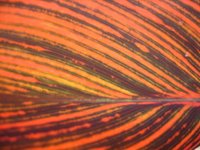
Plant material is fascinating to me. We buy plants for colour, form, fragrance, size, ease of care and a variety of other reasons to place in our gardens. But if we stop for a moment and look really close and study these beautiful growing things, we often are shown a different perspective. They draw us in and reveal a new side, a new way of seeing them. Cells of flowers in the sun sparkle like jewels. Leaf variegation can look like painted fabric. Foliage texture can become eroded mountains and hills. It's like those drawing that you can see two totally different items depending on how you view it. I'm always amazed at how the smallest leaf or the tinniest flower can be so incredible and share with us something new.


Sunday, September 17, 2006
Saturday, September 16, 2006
PERILLA
 Perilla frutescens is a decorative foliage annual ofter mistaken for Coleus. I have always had mine in containers on the deck planted with other part shade plants, but they can be planted in the ground with many other complementary plants. From what I understand several parts of the plant are edible, most commonly the leaves which are suppose to taste kind of cinnamon herbal. I keep mine evenly moist and pinch mid season to keep them full and bushy. There are other foliage colours and shapes but the above pictured is the most common type. I have not tried this, but they look like they would be easy to start from cuttings.
Perilla frutescens is a decorative foliage annual ofter mistaken for Coleus. I have always had mine in containers on the deck planted with other part shade plants, but they can be planted in the ground with many other complementary plants. From what I understand several parts of the plant are edible, most commonly the leaves which are suppose to taste kind of cinnamon herbal. I keep mine evenly moist and pinch mid season to keep them full and bushy. There are other foliage colours and shapes but the above pictured is the most common type. I have not tried this, but they look like they would be easy to start from cuttings.
Friday, September 15, 2006
HELENIUM

 Heleniums (SNEEZEWEED) are a very easy care perennials. I've had mine in the garden for three years and really don't do much to them. I have located them in the back part of my largest mixed border. There are dwarf kinds but mine is a standard height (about 4 feet). The one note of caution is to watch for it when it first comes up in the garden. It really looks like a weed when it breaks the ground and can be mistakenly pulled. Make sure you give them plenty of sun and great drainage. They bloom about 8 to 10 weeks and make a great cut flower.
Heleniums (SNEEZEWEED) are a very easy care perennials. I've had mine in the garden for three years and really don't do much to them. I have located them in the back part of my largest mixed border. There are dwarf kinds but mine is a standard height (about 4 feet). The one note of caution is to watch for it when it first comes up in the garden. It really looks like a weed when it breaks the ground and can be mistakenly pulled. Make sure you give them plenty of sun and great drainage. They bloom about 8 to 10 weeks and make a great cut flower.
Tuesday, September 12, 2006
ROSES
Monday, September 11, 2006
GERANIUMS
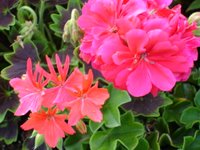
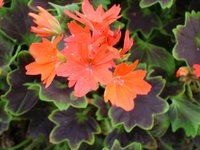
I've been amazed by some gardeners that will pass up some of the traditional favourites for all the latest and greatest plant cultivars and hybrids. They will go to there local nursery or garden centre and not even look at the more common annuals, perennials, shrubs and trees, only to purchase the most resent varieties. Don't misunderstand me, I love seeing and acquiring some of newest plant varieties available, I just think there are some plants that have been around for awhile that shouldn't be looked over. GERANIUMS (Pelargoniums) are one of those plants that come to mind that should have a place in every ones garden. They come in many colours, bloom for months, there are tall ones and short ones, and trialing ones. Many have beautiful foliage. There are doubles and singles, fringed ones, some look even like small star bursts. The below photo is one of my favourites --- Ivy geraniums. Besides the trailing growth habit, I love the bright colours they come in. They have wonderful waxy foliage. And best of all they are very forgiving if I forget water them and they dry out a little. I often tuck them into some of my containers or plant clusters of them in some of my mixed borders.

Sunday, September 10, 2006
AGASTACHE

Agastache foeniculum or as it is know by its common name ANISE HYSSOP is a easy care hardy perennial. It prefers full sun although it can be grown in part sun/part shade and has lovely lavender blue to french blue flowers. A bee and hummingbird favourite, make sure you keep it irrigated weekly, located in good drainage and deadheaded to lengthen blooming period. There are many types of Agastaches but right now I only have this species in my garden. I was attracted to the licorice scented leaves and the french blue flowers. It can get tall but can be kept shorter by pruning to half when the perennial reaches 18" tall. The picture shows how tall it can get before I learned this pruning technique. Next year, in another area of the garden I'll plant Agastache rupestris ( SUNSET HYSSOP). The foliage smells wonderful and has orange flowers ( one of my favourite flower colours).
Saturday, September 09, 2006
PHLOX
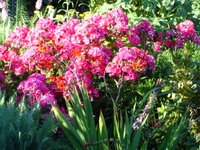
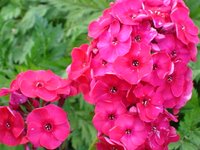
I've had my Garden Phlox ( Phlox paniculata ) for about 4 years. It's a good little producer and really needs very little care. Keep it in full sun with good air circulation ( to keep mildew to a minimum) and mulch to maintain cool roots. It comes in many colors but I've always preferred the brighter stronger colours compared to pastel. Some support maybe need because the stems can be brittle at the base joint. Although all have the fragrance the white seem to be strongest. Hummingbirds and Butterflies love this plant.

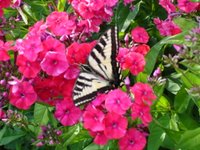
Friday, September 08, 2006
SHADES OF GREEN

 Its been the driest summer in history for the Seattle area. My lawn, which I do not irrigate during the summer, has gone dormant turning a straw colour. Looking more like a Eastern Washington landscape rather than being so close to the Emerald City. Tomorrow night we are receiving our first fall rains. I look forward to it. I remember a short six months ago when the garden was vibrant with many shades of green and springs promise was displayed throughout the yard.
Its been the driest summer in history for the Seattle area. My lawn, which I do not irrigate during the summer, has gone dormant turning a straw colour. Looking more like a Eastern Washington landscape rather than being so close to the Emerald City. Tomorrow night we are receiving our first fall rains. I look forward to it. I remember a short six months ago when the garden was vibrant with many shades of green and springs promise was displayed throughout the yard.
Monday, September 04, 2006
RUDBECKIA
 Rudbeckia is one of the easiest perennials to grow in the Northwest. With meeting just a few of there minimum requirement's they explode into colour throughout late summer and fall.
Rudbeckia is one of the easiest perennials to grow in the Northwest. With meeting just a few of there minimum requirement's they explode into colour throughout late summer and fall. 
 Locate them in full sun with well drained soil, and weekly water to guarantee an abundance of blossoms. Every several years I divide mine to keep them from over crowding.
Locate them in full sun with well drained soil, and weekly water to guarantee an abundance of blossoms. Every several years I divide mine to keep them from over crowding.
Sunday, September 03, 2006
PERSICARIA
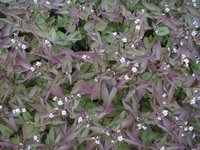
There are many types of Persicarias, all of which have beautiful foliage and some have the edition of lovely flowers. Even though the one pictured above has interesting and decorative foliage it will be remove this fall from the garden because it's to aggressive and has even gone into the lawn. I've battle with it for several years and finally decided to remove it. It's a shame because it has such a pretty little perennial but my mixed borders deserve plants that behave and stay in there place.
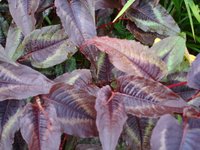
The larger leaved hybrid pictured ( I think its called "Dragons Blood" ) is a better performer. I have it located in front of some Eupatorium (Joe Pye Weed), Echinacia, and other shrubs, perennials, and ground covers that are in the greys, plums, Burgundies and grey-greens to play off the colours in its leaves.
Saturday, September 02, 2006
TITHONIAS

This Mexican and Central American native is a real work horse in the mixed borders. It requires full sun, very little water when established (about two month after sowing), and blooms like crazy until the first frost. The flowers are intense pumpkin orange and foliage is velvety. It even can be enjoyed inside as a cut flower. I tend to plant it with strong saturated colours like yellows, royal blues, and hot pinks. I highly recommend this easy care annual to add some punch to your garden.
Subscribe to:
Posts (Atom)




